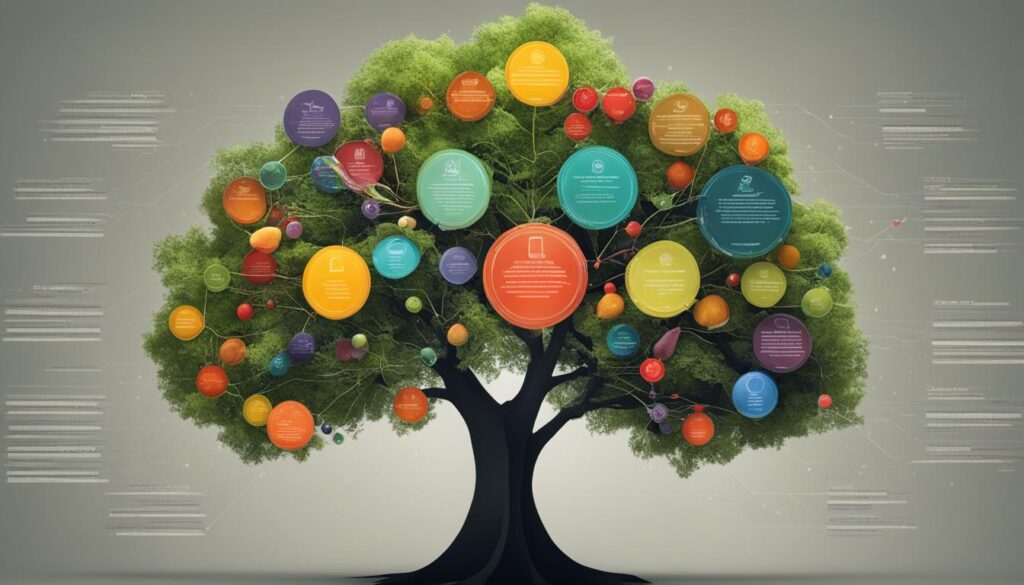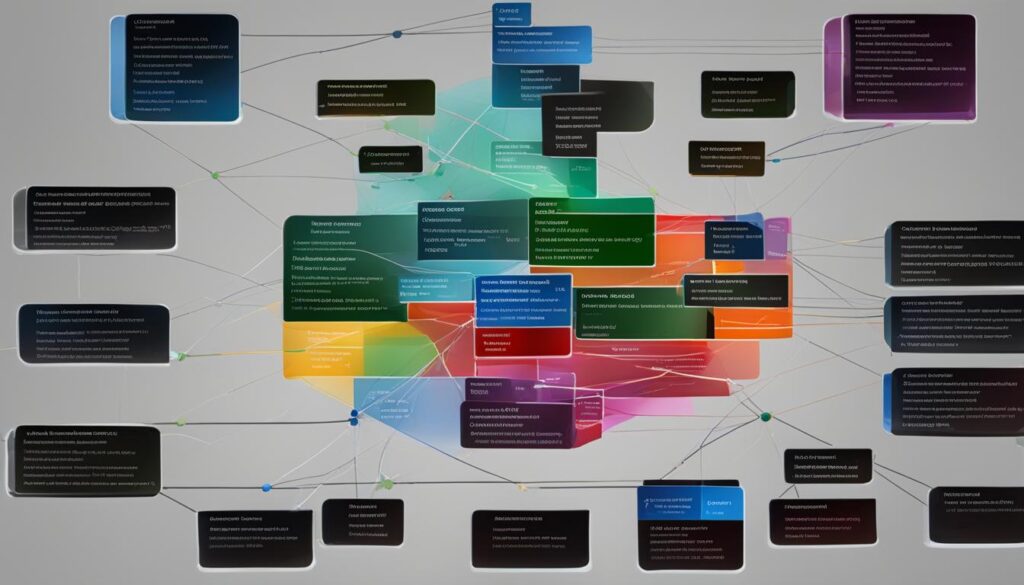Welcome to our quick guide on understanding taxonomy in information technology (IT). Taxonomy refers to a structured system for organizing and classifying content or data. In the context of IT, taxonomy involves creating a closed list of acceptable terms arranged hierarchically, which are used to describe and classify the content. It plays a crucial role in improving content findability, enhancing search results, and supporting efficient information retrieval.
Contents
- 1 The Role of Taxonomy in Organizing Data
- 2 Types of Taxonomy in IT
- 3 Benefits of Using Taxonomy in IT
- 4 Taxonomy vs Classification in Information Technology
- 5 The Impact of Taxonomy on Workflow
- 6 Implementing Taxonomy in IT Systems
- 7 Conclusion
- 8 FAQ
- 8.1 What does taxonomy mean in information technology?
- 8.2 What is the definition of taxonomy?
- 8.3 Can you provide some examples of taxonomy in IT?
- 8.4 What are the types of taxonomy used in IT?
- 8.5 What is the significance of taxonomy in information technology?
- 8.6 How does taxonomy differ from classification in IT?
- 8.7 What impact does taxonomy have on workflow processes?
- 8.8 What is required to implement taxonomy in IT systems?
- 9 Source Links
Key Takeaways:
- Taxonomy in IT refers to a structured system for organizing and classifying content or data.
- It involves creating a closed list of acceptable terms arranged hierarchically.
- Taxonomy improves content findability, enhances search results, and supports efficient information retrieval.
- Examples of taxonomies in IT include tagging content with specific terms for easy navigation.
- There are different types of taxonomies used in IT, such as list taxonomy, tree taxonomy, hierarchical taxonomy, and facet systems.
The Role of Taxonomy in Organizing Data
Taxonomy plays a crucial role in information technology by organizing and structuring data in a meaningful way. It involves categorizing and labeling content with specific terms, enabling effective information retrieval. Through the creation of a hierarchical metadata structure, taxonomy ensures accurate description and classification of content, facilitating efficient organization and search capabilities. The significance of taxonomy in information technology lies in its ability to make content more easily accessible, improve user experience, and enable robust content analysis and reporting.
By implementing taxonomy, businesses can enhance content organization and improve the overall workflow in IT environments. Taxonomy provides a systematic approach to content classification and retrieval, supporting facets and filters for enhanced navigation. This allows users to narrow down search results and find relevant content more efficiently. Additionally, taxonomy aids in content analysis and reporting, providing insights on content performance and user behavior.
“Taxonomy is like a roadmap that helps you navigate through a vast amount of data. It ensures that content is accurately classified and organized, making it easier for users to find what they need.”
With taxonomy, businesses can create a more intuitive and user-friendly experience. It allows for structured navigation and personalized content delivery, tailoring content to specific user attributes or preferences. Furthermore, taxonomy supports content aggregation and segmentation, facilitating the creation of landing pages and targeted campaigns.
Implementing taxonomy in IT systems requires careful planning and the use of taxonomy management software. This software helps define the taxonomy structure, import existing taxonomies, and analyze content for automatic assignment to the appropriate taxonomy categories. Regular updates and maintenance are essential to ensure the taxonomy remains relevant and effective.
Benefits of Taxonomy in Organizing Data
Let’s explore the various benefits of using taxonomy in information technology:
- Improved content findability: Taxonomy enhances content discoverability through structured navigation and improved search results.
- Personalized content delivery: Taxonomy allows for customized content based on specific attributes or facets, providing users with tailored information.
- Efficient content aggregation: Taxonomy facilitates content organization, enabling the creation of landing pages and targeted campaigns.
- Enhanced content analysis and reporting: Taxonomy provides insights into content performance and user behavior, supporting effective analysis and reporting.
The significance of taxonomy in information technology cannot be overstated. It provides a powerful mechanism for organizing and structuring data, improving content discoverability, and enhancing user experience. By embracing taxonomy, businesses can optimize their content management processes and streamline workflows in IT systems.
| Taxonomy classification | Significance |
|---|---|
| Accurate content description and classification | Ensures content is tagged and labeled appropriately for seamless retrieval |
| Enhanced content organization | Facilitates efficient categorization and structuring of data |
| Improved search results | Enables users to find relevant content quickly and easily |
| Supports facets and filters | Allows for refined navigation and targeted content delivery |
| Efficient content analysis and reporting | Provides insights on content performance and user behavior |
Types of Taxonomy in IT
In the field of information technology, different types of taxonomies are utilized to organize and classify content effectively. Let’s explore some of the common types:
List Taxonomy
A list taxonomy involves creating a collection of terms that share a unifying principle. The content is categorized and labeled based on these terms, making it easier to classify and retrieve information.
Tree Taxonomy
In a tree taxonomy, multiple lists are clustered under parent categories, forming a hierarchical structure. Each list represents a specific category, and the hierarchy helps to organize and navigate through the content.
Hierarchical Taxonomy
Hierarchical taxonomies follow strict rules, ensuring that each topic fits into one position within the hierarchy. This structure provides a clear and organized classification system for content organization and retrieval.
Polyhierarchy Taxonomy
Polyhierarchy taxonomies allow topics to have multiple parents, providing more flexibility in classifying content. This allows for a broader and more versatile categorization system.
Facet Systems
Facet systems utilize clearly defined attributes to connect content in various ways. These attributes act as filters, allowing for easy navigation and personalized content delivery based on specific characteristics.
By understanding the different types of taxonomies in IT, organizations can choose the most suitable approach to effectively organize and classify their content, allowing for seamless content retrieval and enhanced user experience.
| Type of Taxonomy | Description |
|---|---|
| List Taxonomy | Creates a collection of terms with a unifying principle to categorize and label content. |
| Tree Taxonomy | Clusters multiple lists under parent categories to form a hierarchical structure for content organization. |
| Hierarchical Taxonomy | Follows strict rules to ensure each topic fits into one position in the taxonomy hierarchy. |
| Polyhierarchy Taxonomy | Allows topics to have multiple parents, offering more flexibility in classifying content. |
| Facet Systems | Uses clearly defined attributes to connect content, facilitating easy navigation and personalized content delivery. |
Benefits of Using Taxonomy in IT
Utilizing taxonomy in IT offers several benefits. Firstly, it enhances content findability by providing structured navigation, improving search results, and offering related content suggestions. Taxonomy enables the efficient categorization and tagging of content, making it easier for users to locate relevant information.
Secondly, taxonomy supports personalized content delivery by allowing for the customization of content based on specific attributes or facets. This means that users can receive tailored content recommendations that align with their preferences, increasing engagement and satisfaction.
Moreover, taxonomy aids in content aggregation and segmentation, facilitating the creation of landing pages and targeted campaigns. By grouping related content together, organizations can create cohesive and compelling user experiences, guiding users through their desired information journey.
Lastly, taxonomy enables effective content analysis and reporting, providing insights into content performance and user behavior. By utilizing taxonomy, organizations can generate valuable metrics and analytics that help optimize content strategy, track user interactions, and identify trends or patterns.
Benefits at a Glance:
- Enhanced content findability
- Personalized content delivery
- Efficient content aggregation and segmentation
- Effective content analysis and reporting
Through these benefits, taxonomy plays a vital role in improving information organization, user experience, and content effectiveness in IT systems.

Testimonial:
“Using taxonomy in our IT infrastructure was a game-changer. It transformed our information retrieval processes, making it a breeze to find relevant content. We were also able to deliver personalized experiences to our users, resulting in increased engagement and customer satisfaction.”
Taxonomy vs Classification in Information Technology
While taxonomy and classification are both important concepts in information technology, they have distinct purposes and roles. Taxonomy refers to the formal structure and organization of content through hierarchical metadata rules. It involves creating a controlled vocabulary and applying specific terms to describe and classify content. On the other hand, classification focuses on categorizing content based on specific criteria or attributes. It can be seen as a broader concept that encompasses the use of taxonomies for organizing content.
Here’s a closer look at the differences between taxonomy and classification:
“Taxonomy is like a well-organized library. It establishes a hierarchical system that labels and groups content based on predefined categories. Classification, on the other hand, is like sorting books based on their genres or authors.”
The Role of Taxonomy:
- Organizes content through hierarchical metadata rules.
- Creates a controlled vocabulary for accurate content description and classification.
- Provides a systematic approach to content organization and retrieval.
- Aims to ensure consistency and accuracy in labeling and categorizing content.
The Role of Classification:
- Categorizes content based on specific criteria or attributes.
- Enables grouping and sorting of content according to different characteristics.
- Allows for customized organization and filtering options.
- Supports the creation of subsets or subsets of content for analysis and reporting purposes.
By understanding the differences between taxonomy and classification, businesses can effectively utilize both concepts in their information technology systems. Taxonomy provides the foundation for structured content organization, while classification offers flexibility and customization options for enhanced information retrieval and analysis.

Image: A visual representation of taxonomy versus classification in information technology.
The Impact of Taxonomy on Workflow
The incorporation of taxonomy in information technology has a significant impact on workflow processes. Taxonomy improves information retrieval by providing structured navigation and facilitating efficient search functionality. By tagging content with specific taxonomy terms, you can easily locate related content and navigate through the available options.
This enhances productivity and reduces the time spent searching for information. Taxonomy also supports faceted navigation, allowing you to apply multiple filters simultaneously and obtain highly specific search results. Overall, taxonomy streamlines workflow processes by making content more accessible, searchable, and organized.
| Benefits of Taxonomy in Workflow | Explanation |
|---|---|
| Structured Navigation | Organizes content for easier navigation and retrieval |
| Efficient Search Functionality | Enables quick search and retrieval of relevant information |
| Enhanced Productivity | Reduces time spent searching for information |
| Faceted Navigation | Allows for simultaneous application of multiple filters |
| Improved Accessibility | Makes content more accessible and user-friendly |

With taxonomy, you can streamline your workflow processes, optimize information retrieval, and improve overall efficiency in an information technology environment.
Implementing Taxonomy in IT Systems
Implementing taxonomy in IT systems requires careful planning and consideration. To successfully implement taxonomy, you need to follow a few key steps:
- Define the taxonomy structure: Start by defining the hierarchies, attributes, and controlled vocabulary that will be used in your taxonomy. This will ensure consistency and accuracy in your content classification.
- Tag and classify content: Once your taxonomy structure is defined, tag and classify your content according to the taxonomy. This will help organize and categorize your content in a meaningful way.
- Utilize taxonomy management software: Consider using taxonomy management software to facilitate the creation, implementation, and maintenance of your taxonomies. This software can help import, convert, and modify existing taxonomies, as well as analyze content to automatically assign it to the appropriate place in the taxonomy.
- Regular updates and maintenance: Keep your taxonomy relevant and effective by performing regular updates and ongoing maintenance. This will ensure that your taxonomy continues to meet the evolving needs of your IT systems.
By following these steps and implementing taxonomy in your IT systems, you can effectively organize and classify your content, improving search functionality and content retrieval.

Conclusion
Taxonomy is a crucial component in information technology that plays a vital role in organizing and classifying content. By providing a structured system for content retrieval, taxonomy improves search functionality and supports personalized content delivery. Different types of taxonomies, such as list, tree, hierarchy, and facet systems, offer flexibility and enhanced navigation options, allowing for efficient content organization.
The benefits of using taxonomy in IT are significant. It improves content findability, making it easier for users to locate the information they need. Additionally, taxonomy enables personalized content delivery by allowing for customized content based on specific attributes. Furthermore, taxonomy facilitates content aggregation and segmentation, making it easier to create specific landing pages and targeted campaigns. Lastly, taxonomy enables effective content analysis and reporting, providing valuable insights into content performance and user behavior.
Taxonomy and classification are closely related concepts in the field of information technology. While taxonomy focuses on creating a formal structure and applying specific terms to describe and classify content, classification involves categorizing content based on specific criteria or attributes. Together, taxonomy and classification ensure consistent and accurate content organization and retrieval.
Implementing taxonomy in IT systems requires careful planning and the use of taxonomy management software. It involves defining the taxonomy structure, tagging and classifying content, and regularly updating and maintaining the taxonomy. By understanding and implementing taxonomy, businesses can optimize their content and improve workflow processes and user experiences in information technology environments.
FAQ
What does taxonomy mean in information technology?
In information technology, taxonomy refers to a structured system for organizing and classifying content or data.
What is the definition of taxonomy?
Taxonomy is the creation of a closed list of acceptable terms that are organized hierarchically to describe and classify content.
Can you provide some examples of taxonomy in IT?
Examples of taxonomy in IT include tagging content with specific terms and creating hierarchies to classify and organize data.
What are the types of taxonomy used in IT?
The types of taxonomy in IT include list taxonomy, tree taxonomy, hierarchical taxonomy, and facet systems.
What is the significance of taxonomy in information technology?
Taxonomy plays a crucial role in organizing and structuring data, improving content retrieval, and enhancing the user experience.
How does taxonomy differ from classification in IT?
Taxonomy refers to the formal structure and organization of content through hierarchical rules, while classification involves categorizing content based on specific criteria or attributes.
What impact does taxonomy have on workflow processes?
Taxonomy improves information retrieval, enhances search functionality, and streamlines content organization, making workflow processes more efficient.
What is required to implement taxonomy in IT systems?
Implementing taxonomy in IT systems requires careful planning, defining the taxonomy structure, tagging and classifying content, and using taxonomy management software for maintenance.




